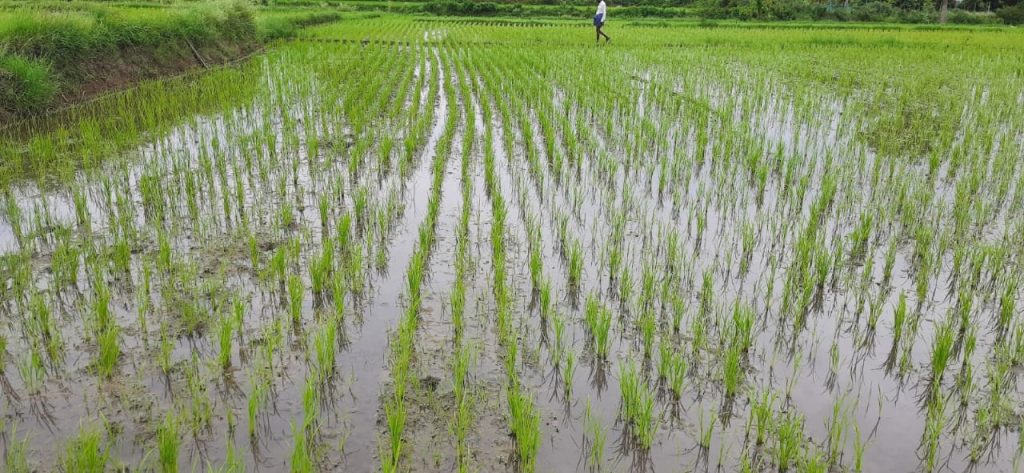Direct sowing of paddy is very beneficial for the farmers

RSD- District news: District Agriculture Officer Bhaskar said that the method of direct sowing of paddy in the irrigated field is very beneficial for the farmers. He issued a statement to this effect on 14.12.2023.
The cost of paddy cultivation has increased in recent times. The cost of labor has increased and it has become difficult to get labor on time. Due to frequent rainy conditions, they are not able to plant rice on time. In some situations, due to timely planting of Nirandaka dark fiber or damage to the fiber, we are observing that the yields of plants are decreasing. In such circumstances, to reduce the cost of cultivation and overcome the problem of laborers, an alternative method to the traditional planting of juniper has been brought into practice in the farmers’ fields.
Benefits of this cultivation
1. Seed saving is 15-20 kg per acre.
2. The crop is harvested 7-10 days earlier.
3. Cultivation cost per acre is Rs. 2500/- reduced down from Rs.3000/-.
4. Adequate plant density increases yield by 10-15 percent.
5. More area can be sown in less time.
6. Labor shortage can be overcome. Dependence on labor will decrease.
7. There is an opportunity to cultivate rice when water is available without losing the growing season in adverse weather conditions.
8. This method is more suitable in summer than monsoon.
Techniques of direct seeding:
1. Soils: All soils normally used for rice cultivation are suitable, except loamy/alkaline/acidic soils. Lands prone to flooding are not suitable for cultivation.
2. Seed rate: 10-15 kg per acre depending on the variety. Varieties with strong stem and strong root system and non-falling varieties are best suited. Any type suitable for the area and preferred by the farmer can be cultivated in this manner.
3. Soaking the seed: Soak the seeds for 24 hours and keep the soaked seeds in a sack or cover the sack for 24 hours. If seen after 24 hours, the nose of the seeds will be cracked and white. Temperature is low during Rabi crop season. So it should be tied from 36 hours.
4. Preparation of the main field: This method should be prepared in the same way as the land is prepared in the normal method of paddy planting. Flatten as much as possible. If the large fields are divided into small areas, it is very suitable for flattening, watering and sowing seeds. Sprouted seeds should be scattered or sown in a drum seeder.
5. Labor required for sowing: Only two laborers are required to sow an acre in this method. One man is needed to pull the drum seeder, another man to fill the seeds and change the rope.
6. Time taken for sowing: 2 hours are enough to sow one acre. Up to 3 acres can be sown in a day.
7. Proprietary Fertilizers: For this method also the usual recommended dose is sufficient. Otherwise only phosphorus fertilizer (full dose) and potash fertilizer (half of recommended dose) should be applied without applying nitrogen fertilizers in the gut. Nitrogen fertilizers should not be applied at the time of sowing as nitrogen fertilization will increase weed growth. Nitrogen fertilizers should be applied in 3 parts 1/3 part at 15-20 days after sowing, 1/3 part at 40-45 days after sowing and remaining 1/3 part nitrogen and half potash at 60-65 days after sowing.
8. Water Management: From sowing to tillering stage, the field should not be waterlogged but only muddy. Drains should be provided to drain excess water. This results in healthier roots and more shoots. 2 cm from pea stomach stage to 10 days before harvest. Ensure that water is stored.
9. Insect and pest control: Insect and pest infestation is less in this method as compared to conventional rice cultivation. Good circulation of air and light to the plants will help the plants to grow healthy. Plant protection should be carried out in the same way as normal paddy cultivation to prevent pests.
10. Harvesting: Any variety can be harvested a week to days earlier as compared to the conventional method. This method gives 10 to 15 percent higher yield as compared to conventional method. Even if the farmer gets a normal yield, the farmer’s expenditure on the cultivation of sugarcane, pulping and planting will be reduced in this method. The district agriculture officer said that the net income will be higher.




